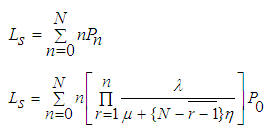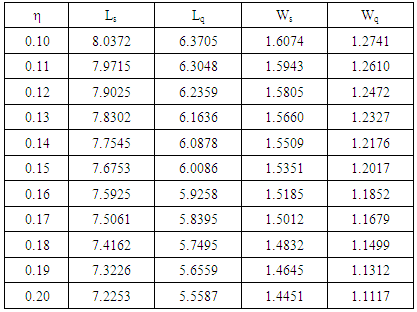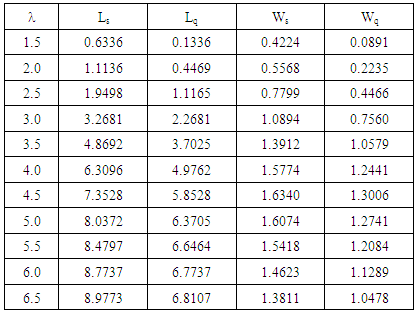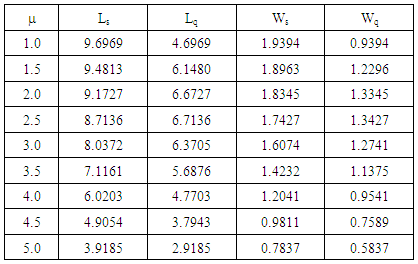-
Paper Information
- Paper Submission
-
Journal Information
- About This Journal
- Editorial Board
- Current Issue
- Archive
- Author Guidelines
- Contact Us
American Journal of Operational Research
p-ISSN: 2324-6537 e-ISSN: 2324-6545
2015; 5(5): 125-128
doi:10.5923/j.ajor.20150505.03

A Finite Capacity Single Server Queuing System with Reverse Reneging
Rakesh Kumar1, Bhupender Kumar Som2
1School of Mathematics, Shri Mata Vaishno Devi University, Katra, India
2Management Department, Jagan Institute of Management Studies, New Delhi, India
Correspondence to: Rakesh Kumar, School of Mathematics, Shri Mata Vaishno Devi University, Katra, India.
| Email: |  |
Copyright © 2015 Scientific & Academic Publishing. All Rights Reserved.
This work is licensed under the Creative Commons Attribution International License (CC BY).
http://creativecommons.org/licenses/by/4.0/

In this paper, we develop and introduce the concept of reverse reneging in queuing theory. We study a finite capacity, single-server Markovian queuing model with reverse reneging. The queuing model developed in this paper is a new advancement in the theory of queues. The steady-state solution of the model is obtained and different measures of performance are derived. Finally, the sensitivity analysis of the model is performed.
Keywords: Reverse reneging, Queuing Systems, Steady-State solution, Sensitivity analysis, Measures of performance
Cite this paper: Rakesh Kumar, Bhupender Kumar Som, A Finite Capacity Single Server Queuing System with Reverse Reneging, American Journal of Operational Research, Vol. 5 No. 5, 2015, pp. 125-128. doi: 10.5923/j.ajor.20150505.03.
Article Outline
1. Introduction
- Managing and ensuring sustainable growth in business is a challenging task due to highly uncertain economic environment. Customers’ behaviour is one of the most uncertain aspects of business. Customer impatience is one of such behaviours. A customer may get impatient due to delay in service, lack of facilities or else and decides to leave the facility before completion of service. This behaviour leads to the loss in revenue as well as the loss in goodwill of the company. Hence customer impatience (reneging) is a threat to any business. Keeping this in mind, researchers across the world study various stochastic queuing models with reneging (classical reneging). Classical reneging is a function of system size. It increases with the increase in system size and vice-versa. The notion of customer impatience appears in queuing theory in the work of (Haight, 1957). He studies M/M/1 queue with balking in which there is a greatest queue length at which the arrival will not balk. (Haight, 1959) studies a queue with reneging in which he studies the problem like how to make rational decision while waiting in the queue, the probable effect of this decision etc. (Ancker and Gafarian, 1963a) study M/M/1/N queuing system with balking and reneging and derive its steady-state solution. (Ancker and Gafarian, 1963b) obtain results for a pure balking system by setting the reneging parameter equal to zero. (Rao, 1965) study a queuing process of type M/G/1 where units balk as well as renege. For further studies on balking and reneging one may refer (Rao, 1967), (Robert,1979), (Baccelli et al., 1984), (Gupta, 1995), (Bae and Kim, 2010), (Manoharan and Jose, 2011), (Liau, 2011), (Kapodistria, 2011), (Choudhury and Medhi, 2011), (Kumar, 2012), (Kumar and Sharma, 2012), (Kumar, 2013), (Kumar et al., 2014) and (Laxmi and Jyothsna, 2015). But when it comes to sensitive businesses like investment, selecting a restaurant for dinner, selecting a service station or choosing a saloon, level of impatience of customers depends upon the amount of trust they show with particular firm. Customers are willing to spend more time with high level of patience with the firms having a large consumers’ base. For instance, if someone is planning to dine out, he is willing to wait for much longer in order to get access to a well-known restaurant. It is also obvious that well-known brands have a large customers’ base. Hence, a large customers’ base also works as a trust factor for a customer and the patience level of the customer is high in such cases. This behaviour is referred to as reverse reneging, according to which, higher system size results in high patience and vice-versa.Owing to this practically valid aspect, we develop a single server stochastic queuing model with reverse reneging in this paper.Notations1/λ = Mean inter-arrival time1/μ = Mean service time 1/η = Mean reneging time Ls = Expected system sizeWs = Average waiting time in the system Wq = Average waiting time in the queueLq = Average length of the queuePn = Probability of n customers in the system P0 = Probability of zero customers in the system
2. Model Assumptions
- 1. The arrivals to the queuing system occur one by one in accordance with a Poisson process with mean rate λ. The inter-arrival times are independently, identically and exponentially distributed with parameter λ.2. There is a single-server and the customers are serviced one by one. The service times are independently, identically and exponentially distributed with parameter µ. 3. The capacity of the system is finite, say N.4. The customers are served in order of their arrival, i.e. the queue discipline is First-Come, First-Served.5. In reverse reneging, the impatience (reneging) is more if there is less number of customers in the system and vice-versa. The reneging times are independently, identically, and exponentially distributed with parameter η. Reverse reneging occurs with rate {N−(n−1)}η, where N, n and 1/η are the system capacity, number of customers in the system, and the reneging times, respectively.
3. Stochastic Model Formulation
- Using Markov chain theory the steady-state equations of the model can be written as:
 | (1) |
 | (2) |
 | (3) |
 | (4) |

 Using condition of normality
Using condition of normality  we get
we get

4. Measures of Performance
- In this section we present some measures of performance. These are helpful in the study and implementation of the queuing model under consideration. First we obtain the expression for expected size, then by using Little’s formula we derive other measures.1. Expected System Size

 2. Expected waiting time of a customer in the system
2. Expected waiting time of a customer in the system 
 3. Expected waiting time of a customer in the queue
3. Expected waiting time of a customer in the queue
 4. Expected queue length
4. Expected queue length

5. Sensitivity Analysis of the Model
- In this section, we perform sensitivity analysis of model. We study the changes in measures of performance with respect to the parameters η, λ, and µ numerically. We select the arbitrary values of η, λ, µ, and N. The values are chosen only for performing the numerical analysis. From Table-1, we can see that as the reneging parameter is increased, the average system size as well as the average waiting time in the system decreases. Similar is the case with average queue length and the average waiting time in the queue. Table-2 shows the variation in performance measures with respect to mean arrival rate. As we increase the mean arrival rate (λ), all the measures show an increasing trend. This can be attributed to the fact that increase in arrival flow leads to the increase in number of customers in the system. From table-3 one can see that with the increase in service rate all the performance measures show a decreasing trend. Increasing service rate leads to decrease in queue length and thus the lower waiting times.
|
|
|
6. Conclusions
- In this paper the concept of reverse reneging is introduced in queuing theory. A single server finite capacity Markovian queuing model with reverse reneging is studied and the steady-state solution of the model is obtained. Various measures of performance are derived. Sensitivity analysis of the model is performed.
 Abstract
Abstract Reference
Reference Full-Text PDF
Full-Text PDF Full-text HTML
Full-text HTML

